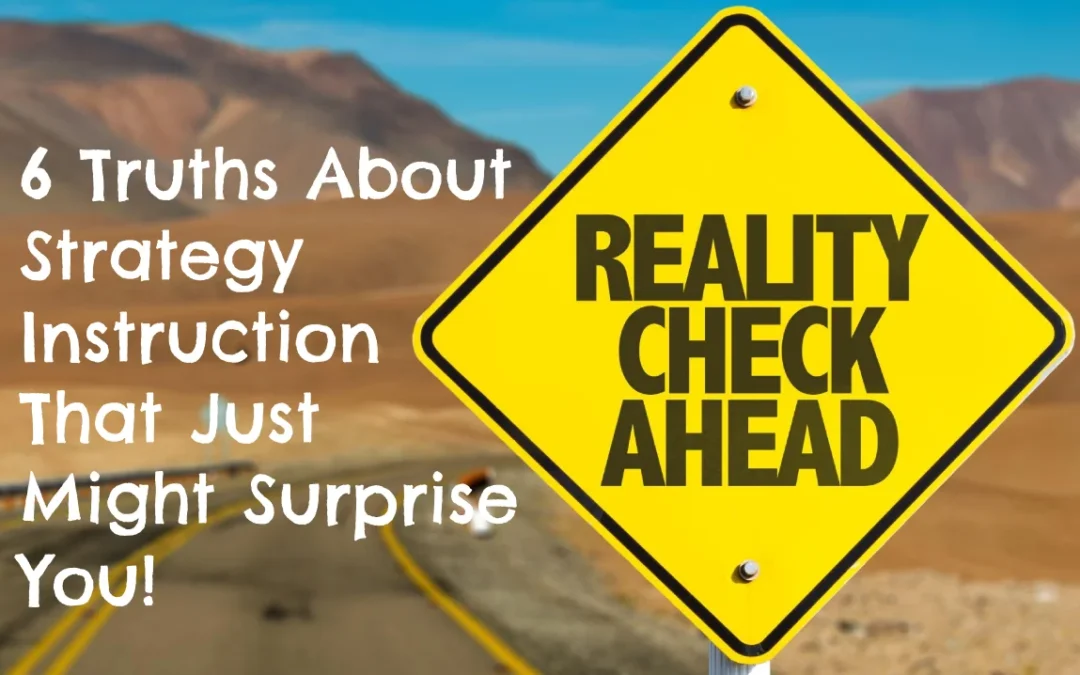If you teach developing readers, you are probably thinking about strategy instruction. Maybe a lot.
In many classrooms, strategy instruction has been the primary vehicle for helping children develop and enhance their reading comprehension.
After all, kids can’t learn to read without reading strategies, right?
While it’s true that comprehension strategies play a significant role in helping readers navigate the meaning of texts, there is also evidence that we could become a bit more “strategic” about how we teach those strategies.
In fact, in many cases, we’ve likely been giving too much attention to strategy instruction, while at the same time not giving enough attention to a few other key contributors to reading comprehension. In the end, this trade-off can actually make it harder for children to learn to comprehend.
So, today, we share with you six truths about strategy instruction that just might surprise you.
Truth #1: A lot of the practices we refer to as “strategies” aren’t actually strategies
From highlighting to jotting thoughts on sticky notes to searching for words that might give clues as to the text’s structures, many of the practices we’ve referred to as “strategies” aren’t actually strategies. Generally speaking, comprehension strategies are those overarching processes essential for reading, but even researchers don’t agree on a specific definition. Because of this confusion and overgeneralization of the term strategy, we choose to refer to the larger processes essential for comprehension—or strategies—as Thinking Moves.
Thinking moves, whether performed with some effort (developing readers) or with automaticity (skilled readers), are on-the-run and in-the-head processes of making sense of a text as we go. No sticky notes or highlighters are required!
Truth #2: Kids don’t need as many strategies as you might think!
Research reveals that children don’t require an extensive number of comprehension strategies. A mere handful is actually sufficient for comprehension. In fact, after thoroughly reviewing the research, we’ve identified just six of these essential overarching processes and refer to them as the Strategic Six Thinking Moves. If you’re curious to know what they are, we’ve written about them in the second Shifting the Balance book, co-authored with Katie Egan Cunningham, and also in this post.
Truth #3: Kids don’t need to practice, and practice, and practice the same strategies over and over.
There is actually a point of diminishing returns when it comes to strategy instruction. Research shows that a handful of lessons on a strategy is just as effective as dozens of lessons (Rosenshein and Meister, 1994; Rosenshine, Meister, and Chapman, 1996; Willingham, 2006). So, spending more time trying to help children acquire a particular strategy just isn’t going to be the best payoff for your investment of instructional minutes. We think this one is a bit of a relief! Maybe we can reclaim a few minutes for other things that also matter (like intentional knowledge-building).
Truth #4: Strategies aren’t best taught one-by-one.
It turns out that strategy instruction is most effective when strategies are modeled and practiced in clusters rather than individually. This is good news because it sets us up to more authentically represent how strategic readers really operate. In the heads of proficient readers, thinking moves aren’t used in fixed, isolated, and linear ways. Instead, their use is dynamic, integrated, and recursive. So, students will benefit when our modeling and think-aloud demonstrate the power of strategies used together. For example, monitoring causes us to stop and reread, which causes us to notice we need to make an important inference, which leaves us with questions . . .
Truth #5: We don’t need to spend time searching for texts to match strategies!
We think this is one of the most exciting shifts to strategy instruction. In the past, with the best of intentions, a whole lot of time has been dedicated to finding the texts that will provide the perfect opportunity to model a particular reading strategy during a lesson. But there is a better way. And this one is a real time-saver. Instead of choosing texts by strategy, we can select rich and wonderful texts that matter for other reasons—alignment to a content area topic or support of our social-emotional learning—with complete confidence that opportunities to model and practice the thinking moves (strategies) that matter most will present themselves in any text that’s worth it’s salt. We explore this kind of text selection in Shift 2 of our 3–5 book.
Truth #6: Strategies alone aren’t enough.
In many classrooms, strategy instruction is the primary vehicle for supporting reading comprehension. But there’s so much more we can and need to do to help readers build a deeper understanding of the texts they read. Two that are on our minds a great deal these days are vocabulary instruction (Shift 3 in our 3–5 book) and intentional knowledge building (Shift 1 in our 3–5 book.).
You probably noticed a pattern here; it’s the thread of good news that runs throughout this post:
When it comes to strategy instruction, less is often more.
If you’re ready to learn how to make learning and applying comprehension strategies easier for the students you teach, we invite you to check out our online class for supporting developing readers (in any grade), where we’ll show you how to shift in your approach to reading strategy instruction.
References:
- Rosenshine, B. and Meister, C. (1994). “Reciprocal teaching: A review of the
research.” Review of Educational Research, 64, 479–530. - Rosenshine, B., Meister, C., and Chapman, S. (1996). “Teaching students to generate questions: A review of the intervention studies.” Review of Educational Research, 66, 181-221.
- Willingham, Daniel T. (2006). “The usefulness of brief instruction in reading comprehension strategies.” American Educator, 30, 39-50.
-

Jan Burkins and Kari Yates are authors, speakers, and consultants, who are dedicated to helping teachers around the world translate reading science into simple instructional moves that help teachers make learning to read easier for their students while still centering meaning-making, engagement, and joy.
Recent Posts


